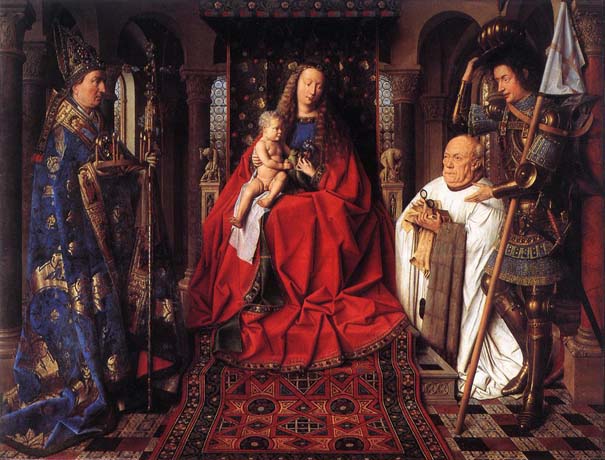To modern eyes, the elaborately wrought paints by Van Eyck could be too much a good thing - all those endless draperies, mind-boggling intricate patterns and infinite details vying with one another for attention. Yet, it was an idiom what rendered Van Eyck's oeuvres so remarkable. His paintings were sumptuous, but these details enhanced, instead of dwarfing the stories and characters. His paintings were far more than just pageantry. Rather, he used the rich background as auxiliary means to tell stories, to add meanings and layers, and more importantly, to add significance and status to his saints and donors, etc. These details were exhaustive but not exhausting. Together, they formed a very specific and special time and space, somewhat fantastic but really idealized. Van Eyck's colors were simply glorious and one could not praise it highly enough. His figures might a tad stiff or mannered, but just as those by Botticelli, they didn't mean to be naturalistic. They were stylized and became immortal in their fixed postures.
I chose the painting below, The Madonna with Canon van der Paele, as one of my very favorite paintings from the Groeninge Museum, Bruges.

Jan van Eyck's The Madonna with Canon van der Paele
Source: ginieland on Wikipedia
For my second favorite from that museum, I chose a copy after Rogier van der Weyden, another giant of the region in 15-16th century.

Copy after Rogier van der Weyden, Saint Luke drawing the Madonna, ca. 1491-1510
This painting, a copy after Rogier van der Weyden, showed Saint Luke, the patron saint of artists, drawing portrait of Mary breast feeding Jesus. The most striking aspect of this group portrait was the calmness of Mary, under close scrutiny, in a rather intimate and private moment, and the obvious pride and joy on her face, and the intensity on the keenly observant face of Saint Luke. He obviously took his task seriously and he knew that he was recording a supremely important event for posterity. To emphasis the status of Mary, Van der Weyden sat her under a brocade canopy, amidst a rather bourgeois interior.
Adding some visual interests were two persons in mid-distance, in typical Flemish dress, surveying a typical Flemish town, tranquil, imperturbable, sharing the same luminosity of the painting itself, a wonderful achievement of Van der Weyden and his copier.
According to Flemish Primitives, "the presentation is based on a legend from the 6th Century, in which it is said that Luke paints the portrait of Mary. For this reason, Saint Luke is the guardian saint of painters, and the guilds in which painters united were often named after him. This story is then also a cherished theme as altarpiece for the chapel of the Saint Luke's guild. The painting from which this Bruges work is a copy, is painted by Rogier van der Weyden before 1440. He probably makes it for the chapel of the Brussels Saint Luke's guild, of which he is a member. The original is preserved in the Museum of Fine Arts in Boston. In addition to the Bruges work, there are also two true copies known that are kept in the Alte Pinakothek in Munich and in the Hermitage in St. Petersburg. The Bruges painting is the best in terms of quality of these copies and was probably painted around 1500."
My Favorite Museum Collection Series
>> My Favorite Museum Collection Series 57: My Favorite Paintings in The Memling Museum The St. John's Hospital in Bruges
<< My Favorite Museum Collection Series 55: My Favorite Paintings in Prince William V Gallery, Den Haag




No comments:
Post a Comment